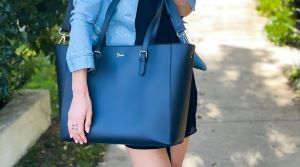A Kansan Cobbler’s Daughter Works with Doshi
The conflicting story of a leatherworker’s daughter joining forces with an innovative vegan brand.
It’s funny to me how life works out. It’s never quite what you expect – the plans that you have don’t match the outcomes, and often, what actually happens is better. I think this might be the case for my working with Paras and the rest of the crew at Doshi, especially considering my background.
How I came from leatherwork to work with Doshi
I am the daughter of a cobbler – my dad was the person that everyone in my Georgia town went to when needing their shoes fixed. He did far more than that, though; his little shop was full of leather hides and strips, which he used to make horse bridles and knife sheathes and gun holsters and many, many more things. I spent a lot of my time there when I was a little kid; to me, the scent of leather was the scent that I caught when I hugged my dad after a long workday, and the animal hide was a tool I could use for idle projects between serving customers at the counter.
As an adult, though, I’ve moved away from that. My father retired a few years ago, selling the shop and its hides, and I began a career as a writer, working freelance to support myself and my own family. I moved to Kansas and stopped thinking about leather beyond vague nostalgia.
When I got in touch with Paras, I didn’t have the highest opinion on vegan leather. My image of it had always been that cheap, peeling stuff my dad would turn away from the shop – it’s not something that can be fixed, as trying to stitch it back into place after it’s pulled away would simply rip it to threads. I had a cheap, faux-leather jacket like this when I was young; my dad had always hated it and begged me to get one made from the genuine article. It lasted a couple of years before it was peeling and tearing and nothing more than a ragged mess. So the idea of false leathers left a bad taste in my mouth.
The longer I work here, though, the more I realize that what I experienced was simply the bottom of the barrel when it comes to materials. Doshi’s products are far more beautiful than the dime-store products I was familiar with; they’re durable and strong, designed well enough to last as long as their animal-based counterparts. They’re made from far more interesting materials pineapples and paper, which I never even considered as a possibility.
Better than any of that, Doshi’s products don’t feed into a vicious cycle of abuse. Though I’d grown up around it, I’d never actually seen how leather was produced. On a surface level, I understood: the animal was raised, then slaughtered, then its skin was treated and shipped to us for use. It wasn’t until I looked closer for Doshi that I realized exactly how badly the animals were treated, how many were slaughtered annually and wastefully used for only their skin, how intensely bad the chemical tanning agents were for the environment, and how detrimental the entire industry is to our planet long-term.
It made me appreciate even more working with a brand that cares so much about the sustainability and kindness of its products, from material sourcing to production to reinvesting in charity. The team behind Doshi is wildly passionate and dedicated to improving the fashion industry long-term by leading through example. I couldn’t ask for better colleagues.
The quirks of working with vegan brands
Of course, working with a vegan brand has its little quirks.
Firstly, it’s difficult to make people understand why I do it. My dad, of course, is still of the opinion that leather is superior in quality, and being in a cattle-raising county in Kansas, it’s difficult to find anyone who agrees with Doshi’s work. I don’t try to argue with them – it’s difficult to admit that your livelihood is hurting the planet. I suppose you can’t please everyone.
Beyond this, most people I’ve spoken with have the same misconceptions I had about vegan materials. They associate “vegan leather” with PU leather and its peeling inability to survive like genuine leather. Strangely, though, I’ve found the best way to combat this is to bring up the interesting materials that Doshi uses. I love watching people’s faces light up when I tell them that we carry wallets made from the waste of pineapple production, or that we have beautiful belts made with microfiber that looks and feels like genuine leather.
I also occasionally get the comment that working for a vegan fashion brand is not only pointless but pretentious. “They’re stuck up,” a friend said to me once, “all vegans are so self-important it hurts.” It’s another weird stigma, I think. I’ve definitely met some pushy vegans, but not on the Doshi team. In fact, not everyone who works on the team is vegan – I’m not – and the ones who aren’t never get any flak from the ones who are. In fact, everyone I’ve worked with, from my writing team to the leadership group, has been nothing but polite, understanding, and fun to talk to.
Conclusion
I’m not perfect. But I see working with Doshi and brands like them as a step in the right direction. I believe that taking action at the corporate level against climate change and animal cruelty is something that should be applauded, and that Doshi has the right idea about it.
The smell of leather will always be nostalgic for me, but that doesn’t mean I have to keep contributing to its production, and it doesn’t mean I can’t support the innovative ways that people are learning to make it obsolete.
More information about Doshi can be found at https://doshi.shop/

